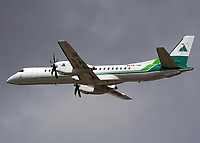PlaneSpottingWorld welcomes all new members! Please gives your ideas at the Terminal.
Saab 2000

The Saab 2000 is one of the fastest turboprop airplanes in existence; it is able to cruise at a speed of over 665 km/h (360 kt). It is a modified version of the Saab 340.
Saab decided to build the 2000 in December, 1988 due to perceived demand for a high speed turboprop which could approach the speeds of jet aircraft while retaining the efficiency provided by turboprop engines. The Saab 2000 first flew on March 26, 1992, and entered into service in 1994, a few months after its certification by the Joint Aviation Authorities in March and the Federal Aviation Administration in April.
The Saab 2000 had a 15% greater wingspan than the Saab 340, and being over 24 ft. 9 in. (7.55m) longer could fit up to 50 passengers. The 2000 was the first commercial aircraft to use Rolls-Royce AE 2100 turboshaft engines (then built by Allison), driving slow turning six-bladed Dowty Rotol propellers. One engine was mounted on each wing, as in the 340, with the engines placed farther from the fuselage than those of the 340.
Sales of the Saab 2000 were fairly limited, although 34 were operated by Crossair, an airline Swissair had shares in. Due to poor sales, Saab stopped production of the Saab 2000 in 1999. In 2000, only 54 Saab 2000 aircraft were in service. The primary reason for poor sales was the success of low-cost regional jets such as the Embraer ERJ-145 and the Canadair CRJ-200, which provided better performance and passenger comfort for the same initial price. Some have speculated that the high cost of regional jet operation is partially to blame for the plague of bankruptcy that has hit the airline industry, something that high-speed turboprops like the Saab 2000 and its competitors would have prevented [citation needed].
In June 2006, Pakistan finalized the purchase of six Saab 2000 turboprop aircraft to be equipped with the Saab-Ericsson ERIEYE Airborne Early Warning system.
In November 2006 a total of 44 Saab 2000 aircraft remain in airline service, with Carpatair (14), Darwin Airline (3), Eastern Airways (4), FlyLal (2), Golden Air (5), Moldavian Airlines (2), Ostfriesische Lufttransport (3), Portugalia (2), Régional (6) and Swiss International Air Lines (8).[1]
Specifications
Powerplants
- Two 3096 kW (4152 shp) Rolls-Royce Allison AE-2100A turboprops driving six blade constant speed Dowty propellers
Weights
- Operating empty 13,800 kg (30,420 lb)
- Max takeoff 22,800 kg (50,270 lb)
Performance
- Max cruising speed 682 km/h (368 kt) at 25,000 ft
- Long range cruising speed 594 km/h (321 kt)
- Initial rate of climb 2250 ft/min (11.4 m/s)
- Service ceiling 31,000 ft
- High speed range with 50 passengers and reserves 2185 km (1180 nm)
- Range at long range cruising speed 2868 km (1549 nm).
Dimensions
- Wing span 24.76 m (81 ft 3 in)
- Length 27.28 m (89 ft 6 in)
- Height 7.73 m (25 ft 4 in)
- Wing area 55.7 m² (600 sq ft)
Capacity
- Flightcrew of two
- Normal passenger accommodation for 50 at three abreast and 81 cm (32 in) pitch.
- Max seating for 58 at three abreast and 76 cm (30 in) pitch, with repositioned galley and wardrobe
Flight Deck
- Rockwell Collins Pro Line 4 avionics suite with integrated avionics processor (IAP)
- Engine indication and crew alerting system (EICAS)
- Traffic alert and collision avoidance system (TCAS)
- The flight control systems include an attitude heading and reference system (AHRS) and a digital air data system (DADS)
References
- ↑ Flight International, 3-9 October 2006
See also:List of civil aircraft
Lists relating to aviation | |
|---|---|
| General | Timeline of aviation · Aircraft · Aircraft manufacturers · Aircraft engines · Aircraft engine manufacturers · Airports · Airlines |
| Military | Air forces · Aircraft weapons · Missiles · Unmanned aerial vehicles (UAVs) · Experimental aircraft |
| Notable incidents and accidents | Military aviation · Airliners · General aviation · Famous aviation-related deaths |
| Records | Flight airspeed record · Flight distance record · Flight altitude record · Flight endurance record · Most produced aircraft |
de:Saab 2000 es:Saab 2000 it:Saab 2000 ja:サーブ 2000 fi:Saab 2000 sv:Saab 2000
